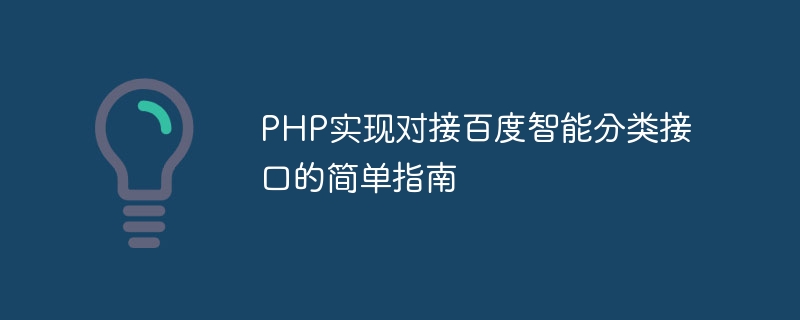Home >Backend Development >PHP Tutorial >A simple guide to implement PHP docking with Baidu intelligent classification interface

A simple guide for PHP to implement docking with Baidu’s intelligent classification interface
In recent years, with the rapid development of artificial intelligence, intelligent classification technology has been widely used in many fields. Baidu Intelligent Classification Interface is one such application, which can classify incoming text data according to it, helping us better understand the content of the text. This article will introduce how to use PHP language to connect to Baidu intelligent classification interface, and give corresponding code examples.
1. Preparation
2. Introducing the SDK of Baidu Intelligent Classification Interface
3. Writing code examples
The following is a simple example code that can be used to connect to Baidu intelligent classification interface:
require_once 'AipNlp. php'; //Introduce Baidu Cloud NLP SDK
// Set APPID/AK/SK
const APP_ID = 'your_app_id';
const API_KEY = 'your_api_key';
const SECRET_KEY = 'your_secret_key';
// Instantiate Baidu Cloud NLP SDK
$client = new AipNlp(APP_ID, API_KEY, SECRET_KEY);
// Enter the text data to be classified
$texts = array(
'你好,我是一名工程师。', '昨天晚上天气很好,我和朋友一起去看电影。', '这部电影的剧情非常精彩,推荐给大家。',
);
// Call the classification interface for text classification
$result = $client->lexer($texts);
// Parse the returned result
if (!empty($result['items'])) {
foreach ($result['items'] as $item) {
$text = $texts[$item['sent_idx']];
$category = $item['item'];
echo "文本:{$text}";
echo "分类:{$category}";
}}
?>
four , Run the sample code
Save the above code as a demo.php file, and set your APPID, API Key and Secret Key in it. Then execute the following command in the terminal or command line to run the code:
php demo.php
After the code is executed, each text data and its corresponding classification result will be output.
Summary
Through the above simple example, we can see that it is very simple to use PHP to connect to Baidu intelligent classification interface and obtain the results. Just introduce Baidu Cloud NLP SDK, set the corresponding parameters, and call the interface for text classification. Mastering this technology, we can apply intelligent classification technology in our own projects to improve the efficiency and accuracy of text processing.
However, it should be noted that Baidu intelligent classification interface is a text-based classification technology, so for other types of data, other interfaces or technologies may need to be used for processing. In addition, accurate classification results also rely on the quality and accuracy of text content. Therefore, in practical applications, we should choose the most appropriate interfaces and methods according to specific needs, and perform necessary preprocessing and cleaning of data to ensure the accuracy of classification results.
I hope this article will be helpful to friends who use PHP to implement Baidu intelligent classification interface. If you have any questions, please leave a message for discussion.
The above is the detailed content of A simple guide to implement PHP docking with Baidu intelligent classification interface. For more information, please follow other related articles on the PHP Chinese website!